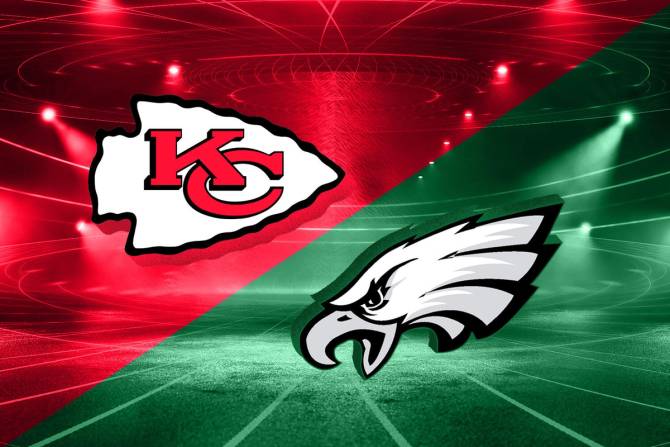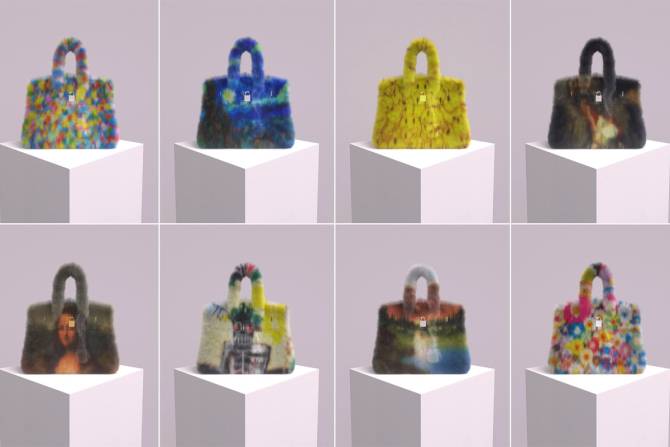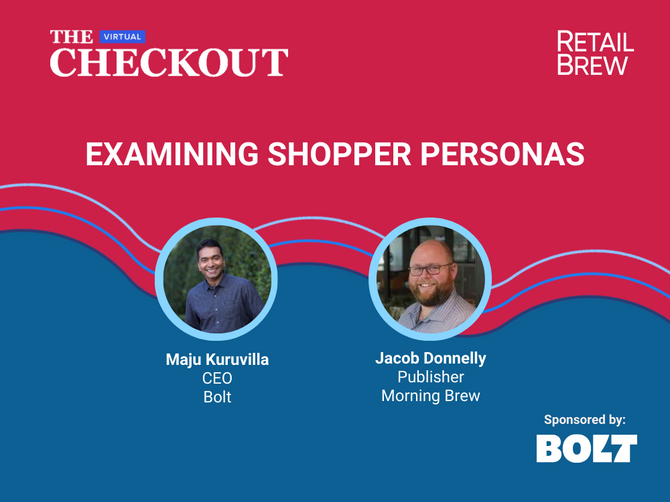Happy Thursday. There are only three more days until the Eagles-Chiefs showdown, but the real nail-biter will be among the Taco Bell fans in Glendale, Arizona, expecting a delivery of its limited-edition Big A** Mexican Pizza. The rest of us will have to be satisfied with the same ol’ chips and salsa.
In today’s edition:
—Maeve Allsup, Jeena Sharma, Katishi Maake
|
|
Illustration: Dianna “Mick” McDougall, Source: Getty Images
If you’re one of those people who tunes in to the Super Bowl mostly to watch the much-anticipated ads, you probably remember last year as the (unofficial) “Crypto Bowl.”
On the retail side of things, LVI was the metaverse Super Bowl: The NFL partnered with gaming world Roblox to sell virtual jerseys, and Miller Lite built a virtual bar in Decentraland for fans to watch the game. “Metaverse” went on to become one of the most viral words of the year, with luxury brands, big box retailers, and everyone in between making moves in virtual worlds.
This year, as the retail world grapples with changing consumer behavior, spending, and perceptions, retail metaverse activations are taking a backseat at the Super Bowl. But that doesn’t mean they’re out of the game for good—they’ll just look a little different.
Clocking the action
Of course, football isn’t the only sport where retail brands are leveraging the metaverse. The LVMH-owned Swiss luxury watch brand Hublot, which has spent four years as the official timekeeper of the FIFA World Cup, unveiled a virtual stadium on Spatial in November.
The brand sees its foray into the metaverse via the Hublot Loves Football Metaverse Stadium as a way to maintain relevance, and even accessibility, with younger consumers, CEO Ricardo Guadalupe told Retail Brew.
- “People are getting curious, and they are getting hooked into the brand through this,” Guadalupe explained.
- Hublot’s metaverse visitors might not be the same demographic as the usual purchasers of luxury watches, but Guadalupe said the metaverse experience serves to start the conversation with those younger consumers (and soccer fans) and create a sense of desirability.
Tian Pei, head of sports partnerships at Roblox, said the intersection of sports, retail, and the metaverse is a natural one, because both sports leagues and retail brands are looking to grab the attention of younger generations.
Keep reading here.—MA
|
|
|
It’s a bird! It’s a plane! It’s…a 2023 retail comeback!
Placer.ai has been keeping their eyes on the skies, and they finally spotted it: 10 brands that’ve developed strategies to help them bounce back from the rough economic times we *all* weathered last year.
And Placer.ai put the deets in this white paper, digging in to important questions like:
- Where are retail chains uncovering expansion potential in underserved markets?
- How can brands capitalize on shifts in consumer preferences?
- When should companies double down on value pricing to appeal to bargain hunters?
Go ahead, call it a comeback. Learn what brands to watch in 2023 and download the full report.
|
|
MetaBirkins
A few weeks ago, we caught you up on the legal battle between Hermès and MetaBirkins creator Mason Rothschild that started about a year ago.
ICYMI, Rothschild created an Hermès-inspired range of NFTs called MetaBirkins that sold for thousands of $$. Hermès claims it constituted a trademark violation, while Rothschild said it was simply a matter of artistic expression.
Both sides delivered their closing arguments in the trademark infringement trial over the past week. The Hermès team maintained Rothschild just wanted to “cash in” on its brand name, and Rothschild countered that MetaBirkin is an “artistic experiment” protected by the First Amendment. On Wednesday, the jury declared that Rothschild had indeed violated Hermès’s trademark and awarded the luxury brand $133,000 in total damages. It also determined that NFTs did not qualify as protected speech.
How did this happen?
Speaking to Retail Brew before the verdict came down, Terence Ross, partner at Katten Muchin Rosenman LLP, said there could have been too many inconsistencies in Rothschild’s argument. “Before the lawsuit was filed…[he said] he intended to pay tribute to the iconic Birkin bag, [which] has very little to do with art, and lots of references to wanting to make money off this,” he told Retail Brew. “So his message has changed over time. And that inconsistency in messaging was pointed out in court during the trial, and most jurors hold inconsistencies against [you]; they think if you’re changing your tune on a regular basis, there’s something wrong with your position.”
What’s next?
This, however, doesn’t mean it’s all over for Rothschild. Even though the jury sided with Hermès, the case could be appealed in the Supreme Court. In fact, the Supreme Court is currently looking at a trademark dispute between Jack Daniels and VIP Products that created a chew toy for dogs resembling the Jack Daniels bottle.
Keep reading here.—JS
|
|
|
Stop guessing. Guesswork is famous for budget draining and painful marketing disasters, but you can insure your brand against failure with Attest’s data-driven insights. Attest gives you a direct line to millions of your ideal customers—and lets you change with them instead of playing catch-up. Learn more.
|
|
Want to know the secret to keeping your customers coming back? Hint: It lies in how deeply you understand them. For more insight, join us on Feb. 23 at 12pm EST for a free virtual event sponsored by Bolt. We’ll chat with industry experts, hear key findings from Bolt’s report on shopper personas, and more. Sign up here.
*This editorial content is supported by Bolt.
|
|
Today’s top retail reads.
By the bootstraps: When you think of Timberland, boots are what first come to mind. But the company is attempting to change that perception with more collaborations, product innovation, and leaning into apparel. (Business of Fashion)
On full display: Pattern Brands, a DTC holding company, recently made the leap into brick and mortar with its first physical store, which it sees as a tool to bring new brands into the fold. “What’s different there is that we’re able to show our products within the context of the home we’re creating with Pattern in general,” co-founder Nick Ling said. (Modern Retail)
Fashion forward: Luxury brands are selling kids’ high-top sneakers for as much as $600, and parents are buying them. High-end childrenswear is a market that is growing faster than menswear and womenswear. (The Cut)
The DTC VIP: Mobile shopping apps drive 7x higher conversions than mobile web. So apps aren’t just “nice to haves”—they’re game changers. Snag NewStore’s consumer app ebook for all the ins and outs.* *This is sponsored advertising content.
|
|
-
Unilever says it will continue to raise prices on select items but start to ease those hikes in the second half of the year.
-
Ebay will lay off roughly 4% of its workforce.
-
Ivy Park, Beyoncé’s clothing brand in partnership with Adidas, is struggling with sales.
-
Canada Goose will double its number of stores over the next five years.
-
Under Armour exceeded revenue expectations despite inventory challenges.
-
Mattel fell short of Q4 earnings expectations as holiday sales dipped.
|
|
The numbers you need to know.
We’re one month into 2023, and things are looking up for third-party sellers. Despite ongoing concerns about the economy, 89% of Amazon sellers reported profitability in the new year, and the majority plan to expand their e-commerce footprint this year, according to a report from Jungle Scout.
Although prices continue to rise, 37% of sellers said their profits increased on a year over year basis. Plus, 31% of Amazon sellers are meeting consumers where they are by using TikTok ads, a 65% YoY increase.
- A majority of sellers (61%) sell on at least one other e-commerce platform, including eBay, Shopify, and Walmart.
- However, 52% plan to expand to more platforms in 2023, a 25% increase from those who said the same a year ago.
Although fewer Amazon sellers lost sales due to supply-chain disruptions in the past year (46% in 2022 compared to 74% in 2021), sellers are still concerned over the costs of shipping, storage, and products from global suppliers.
“This year, we expect to see Amazon sellers exploring new strategies to help them stay ahead of the curve, including expanding into international markets, bringing their brand to new ecommerce platforms like Shopify or Walmart, or promoting their brand on TikTok to drive awareness and sales,” Mike Scheschuk, president of small and medium business at Jungle Scout, said.—KM
|
|
Catch up on the Retail Brew stories you may have missed.
|
|
|
Written by
Maeve Allsup, Jeena Sharma, and Katishi Maake
Was this email forwarded to you? Sign up
here.
Take The Brew to work
Get smarter in just 5 minutes
Business education without the BS
Interested in podcasts?
|
ADVERTISE
//
CAREERS
//
SHOP 10% OFF
//
FAQ
Update your email preferences or unsubscribe
here.
View our privacy policy
here.
Copyright ©
2023
Morning Brew. All rights reserved.
22 W 19th St, 4th Floor, New York, NY 10011
|
|








